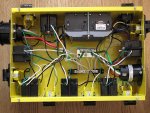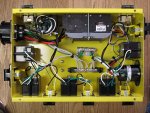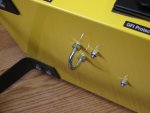I decided that a 50A spider box style of distro would suite my needs both for sound and other uses, like construction. The Hubbell version costs as much as a decent power amp or a really nice microphone. (An abused market, if you ask me.) So I looked at the popular -- in the construction trades, at least -- CEP 50A model, that can be had for under $400. In addition, I wanted two L14-30 receptacles so that I could power two amp racks. The standard 50A models come with one 250V 30A (L6-30) receptacle and your choice of six locking or Edison 125V 20A GFCI and overvoltage protected receptacles. I was willing to take the risk that the unit could be modified to suit my needs. It turned out well.
Upon opening it up I found very standard 1 in. wide, 10,000A interrupting capacity, plug-in circuit breakers. The L6-30 is Marinco, and the Edisons are Hubbell (China). I couldn't determine the brand of the 50A Cali in and out, but they look to be of decent quality. The GFCI/overvoltage units are CEP branded. The overall build quality is good in spite of the use of many self-tapping screws, but the sheet metal is thick enough that they hold pretty well. The non-self tapping fasteners all use nylon-insert lock nuts.
I replaced two of the 20A breakers with a 30A double (250V) breaker and replaced a third 20A breaker with a single-space double 20A breaker. I replaced the L6-30 and one of the Edisons with two L14-30s. So I'm down one Edison, to five, and have an extra GFCI, which I left in its hole as a spare. I needed to modify one of the wet-location covers to accommodate the L14-30, easily done with a half-round bastard. I also added a U-bolt to the bottom of the unit for clipping on Kellems and installed threaded inserts for the cover screws in place of the somewhat cheesy self-tapping screws. Before and after pictures below.
Disclaimer: This post is for your amusement only. I am not suggesting that anyone follow my lead in doing such modifications. Anyone stupid enough to try this should understand basic electricity, be familiar, at the very least, with NEC articles 240 and 250, and be able to maintain a high standard of workmanship. If you can't explain the difference between the grounded circuit conductor and the equipment grounding conductor and where and why they are connected, or not, forget about it ~
~ ~:smile:
~:smile:
--Frank



Upon opening it up I found very standard 1 in. wide, 10,000A interrupting capacity, plug-in circuit breakers. The L6-30 is Marinco, and the Edisons are Hubbell (China). I couldn't determine the brand of the 50A Cali in and out, but they look to be of decent quality. The GFCI/overvoltage units are CEP branded. The overall build quality is good in spite of the use of many self-tapping screws, but the sheet metal is thick enough that they hold pretty well. The non-self tapping fasteners all use nylon-insert lock nuts.
I replaced two of the 20A breakers with a 30A double (250V) breaker and replaced a third 20A breaker with a single-space double 20A breaker. I replaced the L6-30 and one of the Edisons with two L14-30s. So I'm down one Edison, to five, and have an extra GFCI, which I left in its hole as a spare. I needed to modify one of the wet-location covers to accommodate the L14-30, easily done with a half-round bastard. I also added a U-bolt to the bottom of the unit for clipping on Kellems and installed threaded inserts for the cover screws in place of the somewhat cheesy self-tapping screws. Before and after pictures below.
Disclaimer: This post is for your amusement only. I am not suggesting that anyone follow my lead in doing such modifications. Anyone stupid enough to try this should understand basic electricity, be familiar, at the very least, with NEC articles 240 and 250, and be able to maintain a high standard of workmanship. If you can't explain the difference between the grounded circuit conductor and the equipment grounding conductor and where and why they are connected, or not, forget about it
--Frank




